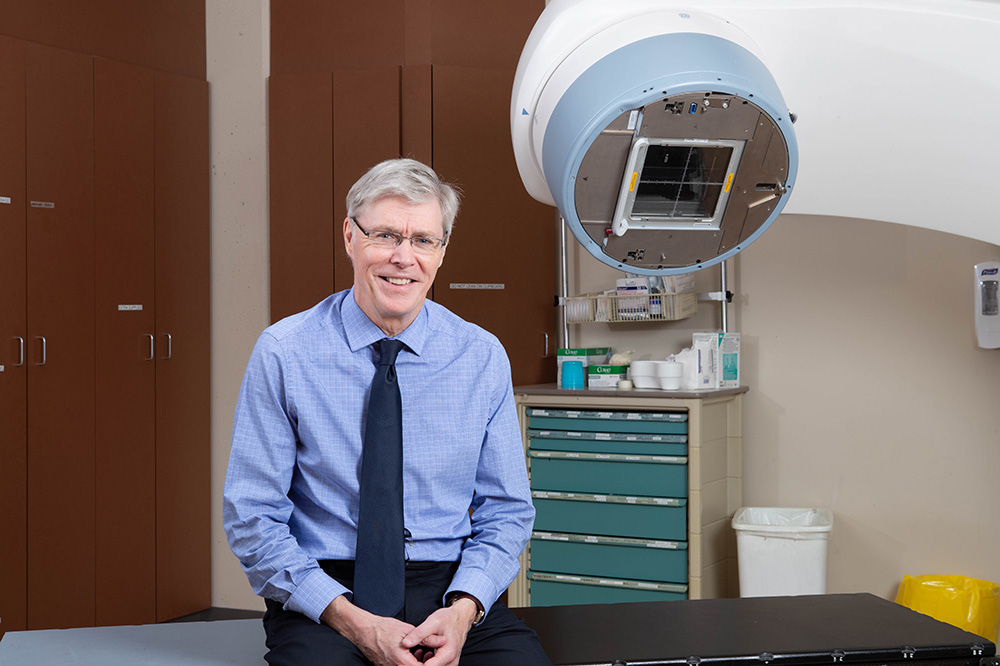Improving radiation therapies from clinical trials to tailored care

Around 70% of breast cancer patients undergo radiation therapy. In early-stage breast cancer, the therapy is typically given after breast-conserving surgery to lower the risk of recurrence and to avoid mastectomy. Thanks to researchers like Dr. Tim Whelan, a radiation oncologist at McMaster University, the standard of care in radiation therapy has advanced significantly in Canada and globally.
When Dr. Whelan began his research career four decades ago, radiation therapy for breast cancer lacked consistency and scientific rigour. Side effects, such as inflamed skin, pain, swelling of the breast, and long-term cosmetic changes to the breast, also greatly affected patients' quality of life.
Determined to improve clinical practice and make radiation therapies more effective and safer for patients, Dr. Whelan embarked on a long journey of groundbreaking research. One of his first studies in the 1990s demonstrated that a larger dose of radiation per day over three weeks was as effective in preventing breast cancer recurrence as the standard five-week treatment, with fewer side effects.
In 2000, Dr. Whelan began a study with support from a Canada Research Chair, the Canadian Breast Cancer Research Initiative and the Canadian Cancer Society. He tested the addition of radiotherapy to the surrounding or regional nodes in axillary node-positive breast cancer.
The study showed that adding radiation of the lymph nodes to whole-breast radiation therapy after lumpectomy (or breast conserving surgery) reduced the risk of cancer recurrence and spread. Dr. Whelan's team also found that some low-risk breast cancer patients may not benefit from the additional radiation therapy. Could this group become candidates for omission of nodal irradiation?
To answer this question, Dr. Whelan and collaborators in the U.S. are conducting the CIHR-funded M.039 trial to identify measurable indicators that will help determine which cancer patients don't need nodal irradiation. "Our results could guide nodal irradiation practices and benefit patients who could avoid nodal irradiation and related side-effects like swelling in the arm and movement limitation," he says.
The early 2000s brought new computer technologies that enabled more targeted therapies such as partial breast irradiation, which focuses on specific areas while sparing healthy tissues. With support from CIHR, Dr. Whelan's team investigated if this approach was effective in treating low-risk breast cancer.
In the RAPID trial, the team showed that delivering larger doses of radiation over one week to targeted areas of the breast at risk was as effective as whole-breast radiation given over three or five weeks. Accelerated partial radiation caused fewer acute side effects, but some patients reported long-term cosmetic alterations in the breast.
Now, in the RAPID 2 trial, also funded by CIHR, Dr. Whelan is working with patients to reduce the long-term side effects caused by this approach. Patients are providing cosmetic assessments to identify the impact of the therapy.
"Our job is not only to improve patient survival and limit side effects but also to listen to patients, understand their challenges, and work with them to identify better therapies," explains Dr. Whelan.
Dr. Whelan's long research journey has improved radiation therapy strategies and influenced breast cancer care standards, making these therapies more effective, cost-efficient, and patient-centred. As he puts it:
"When patients can undergo accelerated radiation or avoid radiation altogether, they experience fewer side effects, and when hospitals and clinics use radiation resources more efficiently, the health care system saves on the costs of unnecessary treatments and their side effects."
It's a win-win.
Dr. Whelan was appointed to the Order of Canada in 2025 for his research, which redefined radiation therapy's use in the treatment of breast cancer.
At a glance
Issue
Radiation therapy is commonly given to early-stage breast cancer patients after a breast-conserving surgery to lower the risk that the cancer will return to the breast. However, patients and providers were concerned about acute- and long-term side effects of the radiation.
Research
Dr. Tim Whelan's research has improved patient outcomes and reduced side effects. He has helped hospitals and clinics use radiation resources more efficiently, and many of the breast radiation therapies he evaluated are now standards of care.
- Date modified: